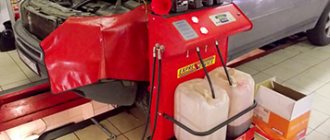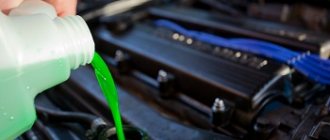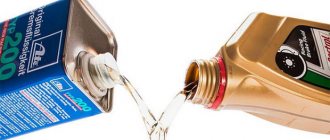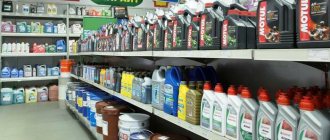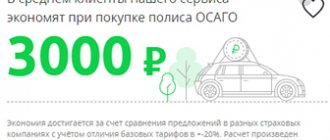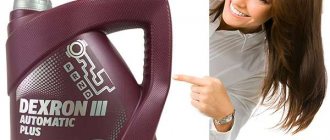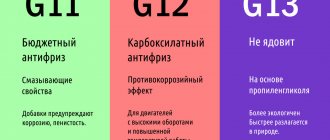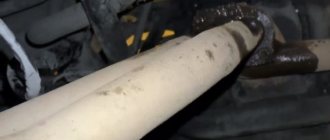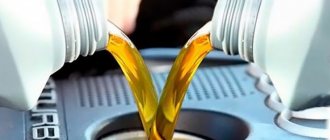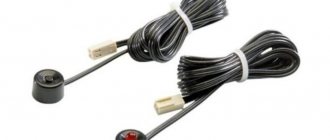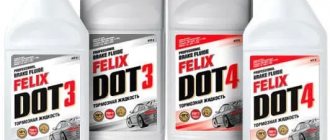Hello again, friends, today I will share useful information about mixing brake fluids. Often you don’t know or don’t remember what kind of fluid was poured into the brake reservoir. And the time has come to top up or change it. If it's time for you to change the fluid, read my article on replacing brake fluid yourself.
But this article will help you top it up correctly. Is it possible to mix brake fluid when adding brake fluid to the reservoir when there is not enough old? What will happen? What are the dangers of mixing? Which ones are allowed to be mixed? Is it worth listening to the advice of the “crazy people”, “Kulibins” and other craftsmen to spoil their own and other people’s cars? I'll tell you now.
What are there
I'll start with the types (varieties) of brake fluids, there are not so many of them, but still should not be confused:
- I also found BSK - it was used in old GAZ cars, it cannot be mixed with anything.
- Later, when the DOT brand appeared, DOT-1 and 2 were popular at first. They were produced on a mineral base, now they are not produced or used, they could only be mixed with each other, not with others.
- Today, DOT-3,4,5.1, which are glycol-based, are relevant in use, which allows them to be mixed with each other, but is not always recommended.
- They should not be confused with DOT-5 and 5.1ABS; these fluids are different, silicone-based and work on racing cars and sports cars where increased braking performance is required.
What is liquid needed for?
Brake fluid is a mixture that helps stop a car. It can withstand high temperatures and does not boil when heated. By pouring the substance into the tank once, the driver can safely drive for about 3 years. This period is relative, as it depends on weather conditions and operating conditions of the machine.
Typically, the fuel tank is replaced after a breakdown has occurred. A broken hose, a leaking mixture—every driver has encountered these problems. It is better to prevent such situations from occurring and to change all important fluids in the car on time.
If a malfunction in the brake system is taken by surprise, the driver begins to frantically add fluid to the tank. However, there is no need to rush. First you need to figure out whether it is possible to mix mixtures at all, and if so, which ones?
Characteristics
There is no point in taking the characteristics of substances that are not used, so for comparison I will give those that you will still find on sale.
| Type | Color | Boiling point | |
| New | With humidity 3.5% | ||
| DOT-3 | Transparent, yellow and to brown | 205 | 140 |
| DOT-4 | Transparent, yellow and to brown | 230 | 155 |
| DOT-5.1 | Transparent, yellow and to brown | 260 | 180 |
| DOT-5/5.1 ABS | Pink to dark red | 260 | 180 |
Initially, they do not contain moisture, but they collect this moisture from the air, therefore, after a few years, the characteristics are greatly reduced, already at a humidity of 3.5%, the boiling point drops by 1.5-2 times. Therefore, store them only in hermetically sealed containers, and the tank must be constantly closed with a lid and not have cracks or holes to prevent air from entering.
The same reason - the accumulation of moisture in the brake fluid, requires periodic replacement of all the fluid inside the system.
Classification
There are several systems for dividing brake fluids: according to viscosity, according to DOT standards, boiling point. In addition, there are generally accepted standards - SAE J 1703, ISO 4925, etc.
The most common of them is gradation according to DOT standards, it consists of:
DOT3 (glycolic)
Recommended for classic cars with front brakes and rear drums.
Main characteristics:
- the boiling point in the “dry” state is not less than 205 degrees, in the “moistened” state (contains 3.5% water) - not less than 140 degrees;
- viscosity at negative temperatures (-40 degrees) – not less than 1500 mm2/s.
DOT4 (glycolic)
Used for modern vehicles with disc brakes on both axles.
Main characteristics:
- the boiling point in the “dry” state is not less than 230 degrees, in the “moistened” state (contains 3.5% water) - not less than 155 degrees;
- viscosity at negative temperatures (-40 degrees) – not less than 1800 mm2/s.
DOT5 (silicone) and DOT5.1 (glycolic)
It is used on sports cars with a fairly high temperature load.
Main characteristics:
- the boiling point in the “dry” state is not less than 260 degrees, in the “moistened” state (contains 3.5% water) - not less than 180 degrees;
- viscosity at negative temperatures (-40 degrees) – not less than 900 mm2/s.
Which one to use?
Many car enthusiasts have a question about what fluid to use, especially those who recently bought a car and received a license. It is recommended to use the specification specified in the manual supplied with the machine. If you have lost your manual, it is now easy to look up the data online.
What should I do if I don’t have the fluid listed in the manual? There are such cases. You need to know which of them are compatible with each other. Let’s say you need DOT-3, you can safely add or replace it with the highest class 4 or 5.1, but only on the same base that allows mixing. Another option is to look at its analogs (ours or imported ones) on the Internet, or ask experts who have encountered this.
For example, using silicone brake fluids when you are prescribed glycolic brake fluids is suicide. Why can’t I use different brands of substances? It’s just that all rubber bands and mechanisms, cuffs, are designed for this type of chemicals; using a different type will cause destruction of the cuffs and seals, leakage and failure of the braking system.
Mixing brake fluid based on silicone and glycol is also prohibited; the difference in composition can cause coagulation and clogging of the system, and this also means brake failure. Serviceable brakes save lives, (and not only yours) remember this.
The use of a lower class of fuel fluid (the third pillbox instead of the fifth, for example), with a reduced boiling point is not desirable, because the calipers heat up, sometimes very much, and if the composition boils, the brake pedal will fail and the car will not stop in a timely manner.
Are pillbox substances from different manufacturers compatible? Yes, they are compatible, the fact is that the DOT marking means a production and composition standard. That is, in fact, manufacturers produce the same substances, according to the standard, provided that it is not a fake.
Kinds
It is customary to divide the brake mixture, which has not yet been used, into moistened and less commonly used - dry.
By dry we mean a mixture that is stored in a freshly opened container. Since car brake mixture is tightly sealed in production when it is first opened, the driver receives a mixture that contains almost no water (if we are talking about a quality product).
By wet we mean a brake mixture that can be used, but which retains a certain amount of water. For example, if a container with such a brake mixture was opened a long time ago, the composition will begin to absorb water from the atmosphere (from the air), for this reason the brake mixture after some time will turn into a moistened one.
It is important to consider: as stated earlier, fuel that has 4.5 percent (or more) water is unsuitable for use.
Therefore, you should check your vehicle before adding it to the car. You can check the amount of water using a special device that can be purchased at car markets.
Russian analogues
Let's look at the Russian analogues for Neva and Tom brakes, and whether they can be mixed with each other and with derivatives of the DOT classification:
- Neva, familiar to many, is produced on the basis of glycol with polyester. It also contains an anti-rust additive. However, the disadvantage is the rapid accumulation of water in it (hygroscopicity), which reduces its characteristics and requires more frequent replacements than others, is considered obsolete, and is gradually going out of production.
- Tom liquid contains glycol ether and a set of additives. Its performance is higher than that of Neva. In terms of quality and composition, it meets the DOT-3 class.
- The same base allows you to mix them with each other, replace the Neva with Tom. In addition, Tom can be mixed with other liquids of the dot-3 class and higher that have a glycol base.
- But can Neva be mixed with Dot 4? It is possible, this has been tested by experience and in practice by many motorists. Only this mixture, due to the fault of the Neva, requires more frequent changes, reducing the time by almost half. Agree, it will be cheaper to completely replace the Neva with a more reliable and long-term analogue.
Is it possible to use brake mixtures of different classes?
As you yourself understand based on the text, brake mixtures can differ significantly from each other in terms of the internal “base” - this “base” can be glycol or silicone, and other differences can only be characterized by the list of additives used.
From this we can conclude that the brake fluid is DOT 3/4/5. 1 is made on the basis of glycols. They can be mixed with each other, but it is worth highlighting that when mixed, the brake fluid changes its composition to a lower-grade one, that is, it inherits the rights of a composition with worse performance properties. This means that if you mix DOT 3 and 5 liquids, you will have a DOT 3 boiling point.
Considering the much higher cost of the higher level brake mixture, such mixing is impractical and can only be used in rare cases.
DOT 5 and DOT 5. 1/ABS. These mixtures are made on the basis of silicone, they can also be mixed with each other in rare cases, but this should not be done, since the compositions of these mixtures are strikingly different.
It is also important to highlight that you can find out information about the brake mixture used in your car in the book on its operation. It is worth following the manufacturer's recommendations and trying to use the brake mixture at the level recommended by the manufacturer.
Important: you should not mix brake fluids that are based on glycol and silicone with each other. This oversight can lead to serious financial expenses to eliminate the consequences and cause damage to the car’s brakes.
Recommendations
Experienced drivers prefer to change the fluid rather than top it up. As a rule, its volumes inside the tank should increase. This happens due to moisture getting into it. If the level of dot 4 (and other fuel fluid) decreases, this is a sign of a leak; before adding, you need to find the leak and fix it.
But here are some tips like: it’s a drag – it’s a drag in Africa too, pour any kind, it’s okay – this is advice from suicides, and for suicides. Even “thank you” for such advice may not work - no one returned from there.
A leak is dangerous because air gets inside the system, which leads to brake failure at the most undesirable moment. So topping up is a last resort measure; it is better to eliminate the leak with a complete fluid replacement and bleeding of the entire system.
Beware of fakes! Which are now everywhere, everywhere and in all industries. Because it's money, it's cheap, it's profitable for scammers. You should not buy something “cheaper”, incomprehensible (unknown brand), and in non-branded stores. You should not take it where it is sold not in bottles, but bottled into your container from barrels! Purchased from dealers, in branded stalls and packages, although somewhat more expensive, but with a guarantee of quality. Moreover, this is not gasoline; you do not need to purchase them often.
I hope now you understand why some liquids cannot be mixed with others, and which ones are allowed to be mixed. This is the key to your safety. The law of meanness comes into play for those who neglect safety - they just forgot to check the brakes - there's a car in front of you, or a person is running across the road! This is not something to joke about. That’s all I have, subscribe to updates, those who haven’t done so, share with your friends, it will also be useful for them to know, and see you later.
